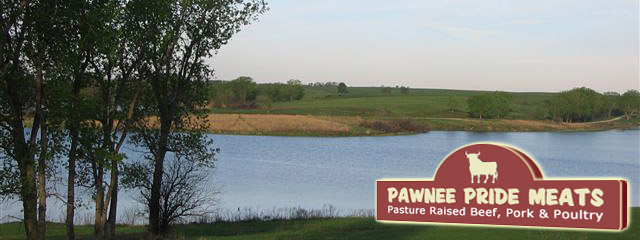

How to Cook Grass Fed Beef – By Paul Rohrbaugh, Pawnee Pride Meats
Cooking grass fed beef is different than cooking industrial/grain fed beef. Or should I say that cooking grain fed is different than cooking the more traditional and natural grass fed beef. The primary difference comes from the fat content. Even well finished grass fed beef steaks are significantly lower in fat and require some care to avoid overcooking, i.e. dryness or toughness. However, the care taken in preparing grass fed beef always results in a tastier, more nutritious eating experience.
If you have ever prepared wild meat from deer, elk, bison, etc., you know that the preparations are different from your typical super market fare. If you cook grass fed beef similar to the way you cook wild game, you will be just fine. In fact, my early cooking experience with grass fed used Wild Game Cookbook recipes. In general, you need to cook grass fed shorter or longer. Let me explain. If you like it rare to medium, you can cook it at a lower temperature for a shorter period of time. 35% less time to be specific. To accomplish this I prefer to use a frying pan (with lid) or a grill (with lid). On the other hand, if you prefer "well done" and/or falling off of the bone meat you need to turn down the heat and turn up the timer (extend the cooking time significantly). In both cases you should be thinking "conservation of moisture". For my "well done" cooking I prefer to use a slow cooking appliance such as a crock pot. I especially like to use this for ribs and roasts and start the cooking process 12-14 hours prior to serving. You may choose to cook shorter or longer.
Some other basics are in the thawing. Never use a microwave. Thaw in the refrigerator for 24-48 hours. Then I marinade for another 24+ hours. The marinade is not essential but is worth the effort. Marinades can be very simple. I started with Italian dressing. Some like beer. Some like fruit juice. Chefs often recommend that you let the beef come to room temperature prior to cooking and then after cooking allow the meat to sit (covered) for 5-10 minutes prior to serving. This is a simple, no cost tip that adds tremendously to the taste and texture of your meat.
Finally, I encourage you to experiment. You began your experimentation by purchasing grass fed beef. Don’t ever give up. If you find that you have overcooked a steak or undercooked some ribs, have a plan B, i.e. beef stew or just throw it into a crock pot, add vegetables, spices and a can of soup. Family favorite recipes are often developed in this way.
There are an infinite number of resources to help you in this adventure. I recommend two good cookbooks: The Grass fed Gourmet by Shannon Hayes and the Wild Game Cookbook available through the Nebraska Game and Parks Commission. There are good sites on the web.. www.csuchico.edu/agr/grasfdbef/recipes/index.html gives recipes as well as a more comprehensive list of cooking tips than I offered above. www.sustainabletable.org/kitchen/recipes offers some exciting recipes. As a last resort, feel free to contact us. I will try to respond within 24 hours, which should give you plenty of time to prepare (or salvage) your grass fed beef.
Pawnee Pride Meats
71718 617th Ave., Steinauer, NE 68441
402-869-2396
pawneepridemeats@gmail.com